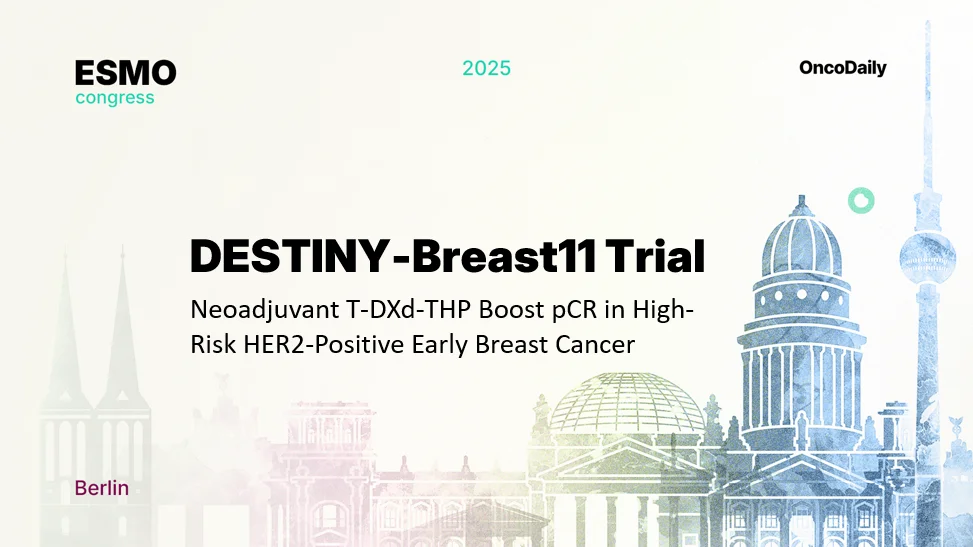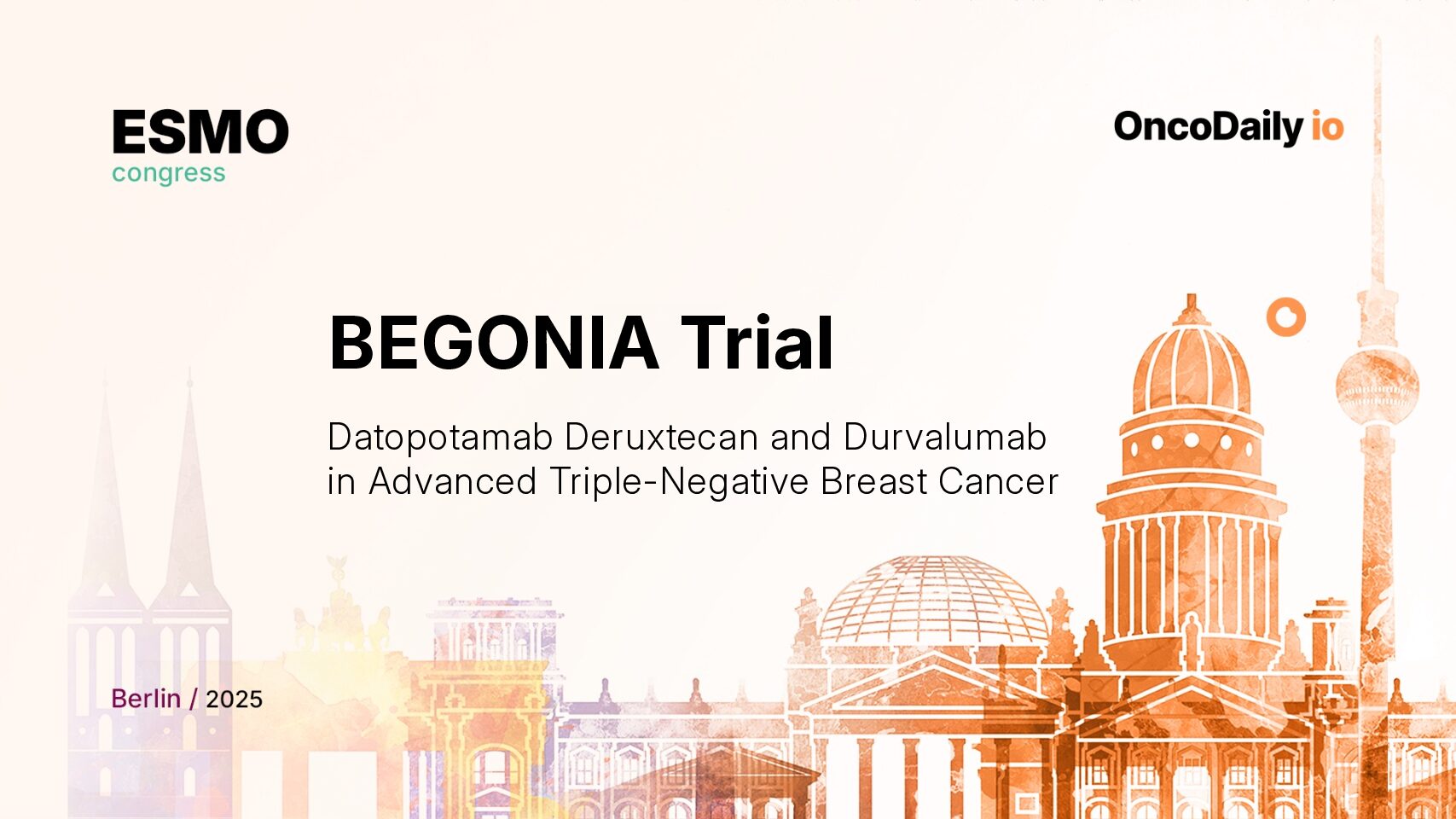Presenter: Peter Schmid, MD, PhD (Barts Cancer Institute, London, UK)
Co-authors: Hwei Chung Wang, Filipa Lynce, Yeon Hee Park, Cynthia X. Ma, Kyung H. Jung, Shin Cheh Chen, Ming-Feng Hou, Catherine Prady, Ling-Ming Tseng, Jamil Asselah, Piotr J. Wysocki, Simon Lord, Purnima Rao-Melacini, Ross Stewart, Karola Warzyszynska, Petra Vukovic, Seock-Ah Im.
Trial ID: NCT03742102
Funding: AstraZeneca (global sponsor) and Daiichi Sankyo (development partner).
Triple-negative breast cancer (TNBC) is an aggressive subtype with limited therapeutic options, and outcomes for patients with unresectable locally advanced or metastatic TNBC (a/mTNBC) remain poor despite advances in immunotherapy. The BEGONIA trial (NCT03742102) is a two-part, open-label, multi-arm platform study evaluating combinations of durvalumab (D)—a PD-L1 inhibitor—with various novel agents in the first-line (1L) setting.
This report focuses on two BEGONIA arms investigating datopotamab deruxtecan (Dato-DXd)—a TROP2-directed antibody-drug conjugate (ADC)—in combination with durvalumab. Arm 7 enrolled patients regardless of PD-L1 status, while Arm 8 included only PD-L1–high tumors (per local immunohistochemistry testing). The aim was to evaluate whether combining TROP2-targeted ADC therapy with PD-L1 blockade could enhance immune activation and induce durable responses.
Methods
Eligible patients had previously untreated unresectable locally advanced or metastatic TNBC and received:
- Dato-DXd 6 mg/kg IV every 3 weeks (Q3W)
- Durvalumab 1120 mg IV Q3W,
- until disease progression or unacceptable toxicity.
- Primary endpoints: safety and tolerability
- Secondary endpoints: confirmed objective response rate (cORR), duration of response (DoR), and progression-free survival (PFS) (per RECIST v1.1).
At data cutoff (November 29, 2024):
- Arm 7: 62 patients (median follow-up 35 months; 19% still on treatment)
- Arm 8: 33 patients (median follow-up 10.7 months; 45% still on treatment)
Results
The Dato-DXd + durvalumab combination demonstrated strong and durable antitumor activity across both study arms:
Arm 7 (all comers):
- Confirmed ORR: 79.0% (95% CI 66.8–88.3)
- Median DoR: 17.6 months (95% CI 10.5–27.3)
- Median PFS: 14.0 months (95% CI 11.0–21.1)
Arm 8 (PD-L1–high tumors):
- Confirmed ORR: 81.8% (95% CI 64.5–93.0)
- Median DoR and PFS: not yet reached due to shorter follow-up (10.7 months)
These response rates are among the highest reported in 1L metastatic TNBC, suggesting a potentially synergistic effectbetween TROP2-directed ADC therapy and PD-L1 inhibition.
Safety
The safety profile of datopotamab deruxtecan (Dato-DXd) plus durvalumab was found to be manageable and consistent with the known toxicities of antibody–drug conjugates (ADCs) and immune checkpoint inhibitors. Adverse events (AEs) occurred in all patients across both study arms, with any-grade AEs reported in 100% of participants. Grade 3 or higher AEs were more frequent in Arm 7 (60%) compared with Arm 8 (36%).
The most common treatment-emergent toxicities included stomatitis and nausea. Stomatitis was observed in 69% of patients in Arm 7 and 82% in Arm 8, with Grade 3/4 severity reported in 16% of Arm 7 patients. Nausea occurred in 68% and 55% of patients in Arms 7 and 8, respectively, but was limited to Grade 1–2 events.
Treatment-related adverse events (TRAEs) were also reported in all patients, with Grade ≥3 TRAEs in 48% of patients in Arm 7 and 24% in Arm 8. Serious AEs occurred in 29% and 15% of patients in Arms 7 and 8, respectively, while treatment discontinuation due to toxicity was required in 19% and 9% of patients.
Interstitial lung disease (ILD) or pneumonitis, a known risk associated with deruxtecan-based ADCs, was infrequent and manageable. There were three cases (5%) in Arm 7—two of Grade 2 and one of Grade 1—and one case (3%) of Grade 2 in Arm 8.
Immune-mediated adverse events were observed in approximately one-third of patients (32% in Arm 7 and 33% in Arm 8), most commonly presenting as hypothyroidism, which occurred in about 23–24% of patients.
One death was reported in Arm 7 but was not attributed to study treatment. Importantly, no new safety signalsemerged, and the overall incidence of ILD was lower than previously observed with other deruxtecan-based ADC therapies, supporting the favorable tolerability of the Dato-DXd and durvalumab combination in the first-line treatment of metastatic TNBC.
Conclusions
The Dato-DXd + durvalumab regimen demonstrated robust and durable clinical activity in the first-line treatment of metastatic TNBC, with high response rates (~80%), prolonged duration of response, and median PFS exceeding one year in unselected patients.
Efficacy was maintained across PD-L1 subgroups, and the safety profile was manageable, with no unexpected toxicities and limited incidence of ILD. These data highlight the potential of TROP2-directed ADC + PD-L1 blockade as a next-generation backbone for TNBC treatment.
The final BEGONIA findings strengthen the rationale for ongoing phase III development of Dato-DXd–based combinations in front-line TNBC, aiming to improve survival outcomes beyond current immunotherapy-chemotherapy standards.

You Can Also Read About DESTINY-Breast11 at ESMO 2025: Neoadjuvant T-DXd-THP Outperforms ddAC-THP in HER2-Positive Early Breast Cancer
